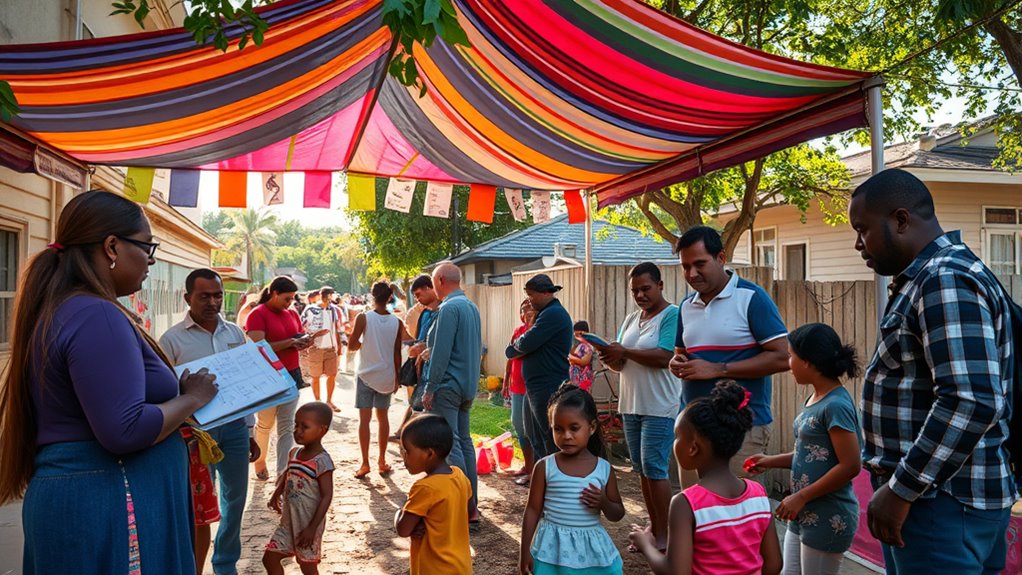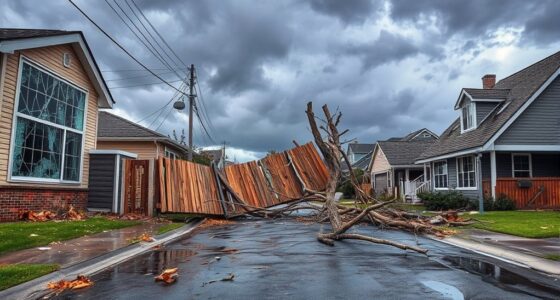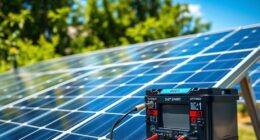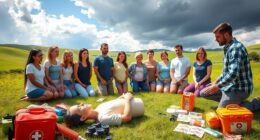Before starting your neighborhood mutual aid, clarify your goals like building community resilience and fostering support. Organize by defining volunteer roles, using outreach methods such as social media and flyers, and ensuring safety with protocols. Communicate effectively through diverse channels to stay connected and engaged. Focus on sustainability by securing funding, building trust, and promoting collaboration. Keep these basics in mind, and you’ll find practical steps to create a strong, lasting support network in your community.
Key Takeaways
- Clarify your community’s specific needs and goals to align mutual aid efforts effectively.
- Identify and recruit diverse volunteers with clear roles and responsibilities.
- Develop inclusive communication strategies using both digital and face-to-face methods.
- Establish safety protocols and sustainable practices to ensure long-term resilience.
- Secure funding and build partnerships with local organizations to support ongoing activities.
What Are the Key Goals of My Neighborhood Mutual Aid Project?

Understanding the key goals of your neighborhood mutual aid project is essential to guaranteeing its success. Your main objectives should focus on building community resilience, providing support to those in need, and fostering a sense of solidarity. Clearly defining these goals helps attract funding sources and creates opportunities for partnership collaborations. Funding sources might include local grants, donations, or small grants from organizations aligned with your mission. Partnership opportunities can involve local businesses, nonprofits, or faith-based groups that share your values. By establishing clear goals, you ensure your efforts align with community needs, making it easier to secure resources and build strong alliances. Additionally, incorporating sustainable practices such as resource management can enhance the long-term viability of your project. This foundation guides your project’s activities and keeps everyone focused on a shared purpose.
How Should I Organize and Recruit Volunteers?

How can you effectively organize and recruit volunteers to support your neighborhood mutual aid project? Start by clearly defining roles and responsibilities to streamline volunteer coordination. Use targeted outreach methods like social media, flyers, or community meetings to attract diverse helpers. Once recruited, assign tasks based on skills and availability, ensuring resource allocation is efficient. Keep volunteers engaged with regular updates and appreciation. Here’s a quick guide:
| Step | Action |
|---|---|
| 1 | Clarify roles and expectations |
| 2 | Use multiple outreach channels |
| 3 | Match tasks to volunteer skills |
| 4 | Share progress and thank volunteers |
| 5 | Adjust resource allocation as needed |
This approach helps build a strong, committed team that can sustain the project long-term. Additionally, understanding best practices in volunteer management can enhance engagement and effectiveness.
What Communication Methods Are Most Effective for Our Community?

Choosing the right communication methods is essential to guarantee your neighborhood mutual aid efforts reach everyone effectively. Digital outreach is a powerful tool for quick updates and broad reach, especially via social media or messaging apps. Community meetings provide face-to-face engagement, building trust and clarifying goals. To maximize impact, consider these methods:
- Use digital outreach platforms like social media, email lists, or neighborhood apps for fast, wide communication.
- Schedule regular community meetings—either in person or virtual—to gather input and foster collaboration.
- Distribute flyers or posters in common areas to reach residents who may not be online.
Balancing digital outreach with community meetings ensures your message is accessible and inclusive, engaging diverse members and strengthening your mutual aid network.
How Can I Ensure Safety and Sustainability in Our Efforts?

To guarantee your neighborhood mutual aid efforts remain safe and sustainable, you need to implement clear protocols and foster ongoing community engagement. Trust building is essential; be transparent about goals, decisions, and resource sharing practices to strengthen relationships. Establish safety guidelines for volunteers and members, ensuring everyone knows how to respond to emergencies and conflicts. Regular communication keeps everyone informed and involved, encouraging accountability. Prioritize resource sharing by organizing supplies efficiently and equitably, preventing burnout or shortages. Building a resilient network relies on consistent collaboration and mutual respect. Incorporating principles from aquatic exercise can also promote physical well-being among volunteers, fostering a healthier, more connected community. By cultivating trust and maintaining open channels, your neighborhood can sustain its mutual aid efforts long-term, ensuring safety while effectively addressing community needs.
Frequently Asked Questions
How Do I Handle Conflicts Within the Mutual Aid Group?
When conflicts arise within your mutual aid group, prioritize conflict resolution through open communication strategies. Encourage everyone to express their concerns calmly and listen actively. Address issues promptly, stay respectful, and seek common ground. If needed, involve a neutral mediator to facilitate understanding. Remember, maintaining trust and cooperation is essential, so keep the focus on shared goals and community well-being. This approach helps resolve conflicts effectively and strengthens your group’s bonds.
What Legal Considerations Should I Be Aware Of?
You should be aware of legal liability and zoning restrictions that could impact your mutual aid activities. Make sure to comprehend local laws around liability, so you’re protected if someone gets hurt or faces issues. Check zoning regulations to ensure your activities are permitted in your neighborhood. Consulting a legal expert or local government can help you navigate these rules, keeping your group compliant and safe.
How Can I Measure the Impact of Our Aid Efforts?
You can measure your aid efforts by tracking volunteer engagement and resource allocation. Keep records of volunteer hours, participation levels, and the distribution of resources to communities in need. Regular surveys and feedback from community members help gauge impact and identify areas for improvement. Monitoring these metrics allows you to see how effectively your efforts are supporting your neighborhood and guarantees resources are being used efficiently to maximize positive change.
What Funding Options Are Available for Neighborhood Projects?
You can explore diverse funding sources like local government grants, community foundations, and crowdfunding platforms to support your neighborhood projects. Start by researching relevant grant applications that match your goals and requirements. Applying for these grants involves preparing clear proposals that highlight your project’s impact and sustainability. Don’t forget to also consider in-kind donations and partnerships, which can supplement your funding sources and strengthen your initiatives.
How Do I Adapt Aid Strategies During Emergencies?
During emergencies, you adapt aid strategies by increasing community engagement and emphasizing resource sharing. You should quickly assess local needs, mobilize volunteers, and coordinate with existing networks. Keep communication open, share resources efficiently, and encourage neighbors to support each other. Flexibility is key—adjust your approach as the situation evolves, ensuring everyone stays informed and connected, so aid remains effective and inclusive throughout the crisis.
Conclusion
Remember, your neighborhood mutual aid project is the heartbeat of your community, pumping life into connections and support. By staying organized, communicating clearly, and prioritizing safety, you can turn a small spark into a blazing fire of solidarity. Keep your efforts steady, like a lighthouse guiding others through stormy seas. Together, you’ll build a resilient, caring neighborhood where everyone’s needs are met and hope shines bright.









